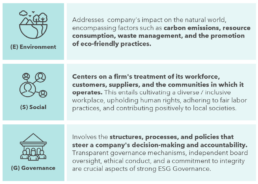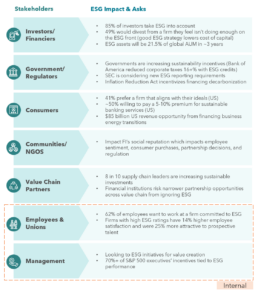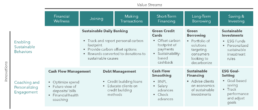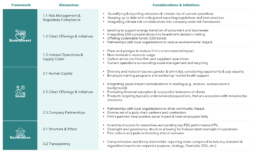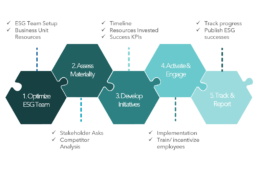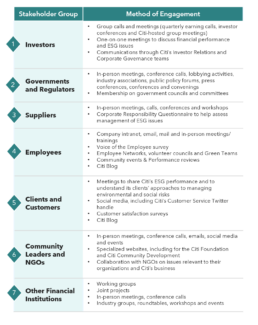The Growing Importance of ESG in Financial Services
First becoming mainstream in a 2004 UN Report titled “Who Cares Wins”, ESG has emerged as a comprehensive framework that can be used to evaluate a firm’s corporate governance, as well as their impact on the environment and society. Initially, ESG considerations were relegated to the sidelines, and firms mainly launched isolated corporate social responsibility initiatives, fulfilling relatively modest demands. However, escalating focus from stakeholders across the banking value chain on global challenges, such as climate change, resource scarcity, and social inequality, has compelled companies to recognize their role in addressing these issues and moved ESG considerations to the core of top performing firm’s corporate strategy and decision-making.
What is driving ESG growth
The rise of ESG has historically been associated with investor-driven initiatives focused mainly on incorporating ESG criteria in the investment allocation process and the use of active ownership to drive outcomes. While this is a major consideration, with ESG-related assets now making up nearly 1/3 of global AUM at $41T,1 over the past decade, several other factors have expanded the scope of Financial Service firm’s ESG considerations including a shifting regulatory environment, increased awareness of ESG risks/ potential value creation, changing consumer and partner expectations, and the potential to improve employee productivity (see exhibit 2).
Exhibit 1. Environment, Social, Governance (ESG) Definition(2)
As the scope of ESG considerations continues to broaden, firms are allocating increased resources to their ESG strategies. This investment is driven by the need to assess shifting stakeholder expectations, evolving regulatory requirements, and the unique needs in different markets and geographies. Furthermore, with ESG initiatives requiring input and resources from employees across business units, companies are increasingly need to reevaluate and adjust their structures to ensure the effective implementation of new initiatives. This often involves restructuring corporate-level org charts and ESG teams to include professionals with diverse expertise, as well as redetermining the company’s ESG decision-making process and incentive structure.
Exhibit 2. Stakeholders Driving ESG Growth (3)
Looking Ahead
ESG adoption among top Financial Services firms is only expected to grow over the coming years. A 2023 survey of executives from 55 financial institutions distributed globally found that 83% expect mounting pressure from regulators, 67% from customers, and 53% from shareholders (4).
Furthermore, the next generation of stakeholders is expected to be even more interested in sustainability. In one of our previous whitepapers, “The Gen Z Effect: Reimagining Financial Services,” we highlighted the distinct amalgamation of traits inherent to Gen Z, including a unique blend of digital fluency, social consciousness, and a penchant for ethical decision-making. In fact, a striking 83% of Gen Z individuals in the US believe that companies should take proactive action to address social and environmental issues, making a strong commitment to sustainability principles a key to remaining competitive in an increasingly Gen Z world.
In the United States alone, Generation Z wields an estimated $148 billion in purchasing power, despite 62% of them not yet having entered the workforce. As the remainder of Gen Z enters employment and inherits their share of the approximately $60 trillion in generational wealth held by Baby Boomers (5), the strategic urgency for companies to adopt a targeted and proactive approach to sustainability becomes even more pronounced and a key driver of good stakeholder relationships.
Financial Services Leaders are Moving Sustainability from the Periphery to the Core
Over the past fifteen years, a rapid transformation has already taken place in the Financial Services sector’s approach to ESG. Notably, between 2006 and 2021, there was a 72% increase in average sustainability scores of top financial services firms, underlining a move of ESG considerations to the core of corporate strategy. This shift has led to an increasingly pronounced divergence between companies fully committed to ESG and those yet to substantially embrace it, allowing for the categorization of financial firms into three distinct stages – ranging from initial peripheral engagement to a deep and proactive integration.
Exhibit 3. Average Refinitiv ESG Pillar Scores of Financial Service Firms in the Stoxx 1800 Global Index (6)
- ESG 1.0: Peripheral Participation. At this stage of maturity, companies primarily engage in isolated corporate social responsibility initiatives, fulfilling relatively modest demands to demonstrate their commitment to societal and environmental concerns. These efforts are often separate from core business activities, existing mainly as add-ons or goodwill gestures to appease stakeholders. However, this approach has led to backlash in some cases, particularly due to allegations of greenwashing. For instance, in mid-2022, Deutsche Bank’s subsidiary DWS was investing approximately $850 million of its ‘green’ funds in fossil fuel companies.7 This led to a loss of consumer trust and the resignation of their chief executive, resulting in regulatory scrutiny.
- ESG 2.0: ESG-Aligned Operations and Products. In this stage, firms begin to create an ESG foundation to embed initiatives in their operations. Example actions include launching dedicated ESG products, aligning their investment strategies with emerging global challenges, and starting to create a cross-functional ESG team to assess risks and identify new opportunities. Firms in this category mostly stay out of ESG related controversies and have established clearly delineated targets and goals for environmental and social impact.
- ESG 3.0: ESG Embedded with Core Business. This stage exemplifies a fundamental integration of ESG principles into the very core of financial services firms. Pro-Active companies embed ESG factors directly into their decision-making processes, from investment choices and risk assessments to product development and stakeholder engagement.
Exhibit 4. Citibank ESG Adoption Timeline (9)
To reach these goals, internal structures and incentives are realigned to reflect a deep commitment to strategic social and environmental impact. Moreover, these firms leverage their data analytics, technology, and collaboration to further drive ESG integration, all while advocating and leading the setting of global standards and best practices.
Many executives believe that choosing to adopt a more robust ESG strategy requires inscrutable trade-offs, forgoing revenue and profit for the sake of society and the planet. That is not always the case. A recent study indicates that financially successful companies that integrate ESG priorities into their growth strategies outperform their peers—provided they also outperform on the fundamentals.8 Moreover, firms within the ESG 3.0 category have and are expected to continue to experience enhanced value creation from leveraging ESG to mitigate risks, enter new markets, engage stakeholders, and attract a younger and growing stakeholder base.
How Sustainability is Being Integrated into Current Operations
Financial Services firms are implementing many ESG initiatives that are industry agnostic. Environmentally, these initiatives target the reduction of carbon emissions and conservation of natural resources. Social priorities include diversity and inclusion, safe working conditions, and community engagement, and governance initiatives focus on transparent reporting, ethical leadership, and board diversity. In addition to these industry-agnostic actions, firms across the financial services sector with high levels of ESG maturity are creatively integrating sustainability criteria into their existing offerings to appeal to consumers and optimize revenue.
Insurance
Insurance companies are integrating ESG factors directly into their risk assessment and underwriting models. This enables them to better understand and price environmental and social risks, resulting in more accurate coverage and pricing. Forward-thinking insurers are also designing innovative products tailored to the challenges posed by climate change, natural disasters, and social disruptions (e.g., flooding and microinsurance). By strategically investing in companies with strong ESG performance, insurers are also aligning their investment portfolios with social and environmental goals. Furthermore, best-in-class firms are leveraging their extensive data resources to inform clients about ESG risks and opportunities, empowering them to make informed decisions.
Private Equity
Private equity firms at the forefront of ESG strategy are embedding sustainability considerations into their due diligence processes and partnering with companies that demonstrate robust sustainability performance. They are also leveraging their expertise to guide portfolio companies towards sustainable practices, driving operational efficiency, reducing carbon emissions, and enhancing social responsibility. Moreover, these firms are fostering sustainability innovation by supporting ESG-focused companies (through double impact funds) and donating to community impact initiatives, nurturing a growing ecosystem of socially conscious businesses.
Asset & Wealth Management
Asset and wealth managers are meeting client demands for ESG-aligned investments by curating thematic portfolios that reflect both clients’ financial goals and sustainability expectations. By meticulously evaluating companies’ ESG performance, they create investment options that drive positive change and responsible business conduct. These managers also use their influence to engage with corporations, advocating for enhanced ESG practices and promoting transparency. Through active ownership and proxy voting, they encourage companies to be more accountable and responsive to stakeholder concerns. Additionally, asset and wealth managers are introducing new educational initiatives, providing their clients with the knowledge and tools necessary to make informed ESG-related decisions.
Banking
ESG-conscious banks are leading the way by offering green bonds for renewable energy projects and curating investment portfolios focused on strong ESG profiles. They are using technology to provide clients with real-time ESG impact tools and incentives for sustainable actions. ESG criteria also influence their lending decisions, directing funds to eco-friendly and socially responsible ventures. Advisory and value-added services further assist clients in navigating sustainable investment decisions, providing them an understanding of the tax credits, grants, and subsidies available among other considerations.
Exhibit 5. Banking ESG Innovations Deep Dive (10)
Exhibit 6. Sample ESG Framework with Initiatives for a Financial Institution (11)
Pain Points for Enabling ESG
Despite mounting pressure on financial services firms to have a comprehensive ESG strategy, many firms are struggling to successfully and efficiently implement new initiatives and are facing high cost and unnecessary delays. The major pain points include:
Exhibit 7. ESG Pain Points
Complexity and Scope: Currently, 42% of Financial Services Institutions report lacking effective processes for addressing climate threats and ESG factors (12). The difficulty of setting up these processes lies in the fact that ESG integration spans across a business’s operations including investment decisions, risk assessments, and reporting. Moreover, the scope extends beyond internal operations, encompassing supply chains, partnerships, and stakeholder engagement. Achieving harmony across these facets necessitates deep sector-specific understanding and the balancing of immediate financial goals with long-term ESG objectives.
Data Collection and Quality: Accurate and reliable ESG data is foundational for informed decision-making and demonstrating the impact of ESG initiatives to stakeholders. The multifaceted nature of ESG metrics demands the aggregation of diverse data points, often sourced from multiple systems and providers. Ensuring data accuracy, consistency, and relevance across various domains, such as carbon emissions, social impact, and governance practices, becomes a complex endeavor. Because of this, CIO input and digital transformation has become a foundational aspect of ESG strategy with 60% of executives polled claiming ESG was either a key criterion or a primary focus of their most recent digital transformations (13).
Resource Allocation: Balancing investments across traditional financial goals and ESG objectives requires careful consideration, and the lack of clear frameworks for assessing the financial returns and long-term benefits of ESG efforts can create uncertainty in resource allocation decisions. Moreover, the evolving landscape of ESG regulations and market dynamics makes it difficult for financial services firms to determine the optimal allocation strategy.
Lack of Accountability: The absence of clear accountability poses a significant challenge for financial service firms in their ESG endeavors. According to a recent survey by Bain & Co., 65% of financial institutions have yet to define primary accountability for identifying and addressing climate risks within their operations and only half of the firms with net-zero commitments had integrated climate metrics into performance evaluations resulting in confusion and low buy-in form frontline staff (14)
Building a Future-Proof ESG Strategy
To effectively address key challenges and formulate a robust ESG (Environmental, Social, and Governance) strategy tailored to their industry and geographical context, financial institutions should undertake a comprehensive five-step approach. This process involves evaluating their current operations and identifying necessary adjustments to enhance their ESG frameworks and current initiatives.
Exhibit 8. ESG Strategy Optimization Steps
- Optimize ESG Team
Although there is not one “correct” approach to embedding sustainability in an organization, to fully capture ESG’s value creation potential companies should ensure their structure allows for: (1) cross-business unit collaboration, (2) adaptation to rapidly changing stakeholder priorities, (3) frontline employee accountability, (4) performance tracking/ adjustment, and (5) partnerships with other firms (e.g., Fintechs, NGOs). The 3 most effective team structures Financial Institutions have been using to set up and implement their ESG strategies are:
Functional Structure: Executive-level ESG committee oversees the development and execution of the institution’s sustainability strategy. This structure ensures high-level coordination and alignment of ESG efforts across different functions. The committee manages the allocation of department resources and ensures that ESG initiatives are integrated into each functional area’s operations.
Matrix Structure: In a matrix structure, each business unit within the financial institution designates an ESG champion who collaborates with a central ESG team. The ESG champions are responsible for driving ESG initiatives within their respective business units while the central ESG team provides guidance, expertise, and support. This encourages decentralized ownership of ESG initiatives while maintaining centralized oversight and knowledge-sharing.
Divisional Structure: Under a divisional structure, the financial institution establishes a dedicated ESG division, often with its own leadership and resources. Agile teams are deployed across different business units to execute specific initiatives, ensuring a targeted and responsive approach. This structure enables rapid adaptation to changing ESG priorities and ensures a well-informed team that is well-versed in sustainability is driving the creation of new initiatives.
Exhibit 9. ESG Team Examples (15)
- Assess Stakeholder Expectations and Materiality
An essential step in building and executing an ESG strategy is a materiality assessment to identify, prioritize, and validate ESG topics of importance to the bank and its stakeholders. While undertaking a materiality assessment ESG teams should:
- Stay abreast of external ESG frameworks and reporting regulations and how they are changing
- Interact with investors and institutional groups to see how material issues from their perspective are evolving
- Hold proactive engagements with diverse stakeholder groups to understand their priorities and identify current gaps in ESG strategy
- Evaluate competitor initiatives in the market and geography in focus
- Develop and Commit to ESG Initiatives
Once the initial materiality and gap assessment has yielded the ESG initiatives of the highest priority the team should develop a roadmap and policy framework for implementing their planned initiatives that include:
- Project timeline with key milestones
- Key stakeholders involved and their responsibilities
- Resources to be invested and results expected
- Key success KPIs
Exhibit 10. How Citibank engages with its stakeholders (16)
- Activate and Engage with Stakeholders
After developing a roadmap and policy framework for the implementation of their ESG agenda, firms should activate their programs and ensure initiatives are effectively integrated and communicated to relevant stakeholders. This step can include:
- Training and educating relevant employees
- Implementing ESG performance-based incentive program to increase buy-in
- Creating and distributing content on ESG program to relevant stakeholders
- Identifying and filling out outside surveys to increase visibility (e.g., Carbon Disclosure Project, Bloomberg Gender Equality Index, Dow Jones Sustainability Index)
- Track and Report Impact
Finally, firms should track and disclose their progress, goals and achievements as part of their public reporting (incl. CEO letter, annual reports, internal corporate communications, and/or annual sustainability reports), and continuously monitor the effectiveness of their ESG initiatives to help determine future adjustments.
By following this comprehensive framework, financial services organizations can methodically plan, implement, and integrate ESG initiatives in an efficient and cost-effective manner.
In Closing..
Financial services stakeholders increasingly expect firms to have a proactive ESG approach tailored to their needs. This includes having sustainable product offerings as well as good internal operations and external targets. In addition, due to an influx of younger and more socially conscious stakeholders entering the working world and gaining consumer power the strategic advantage of going big on ESG now is only expected to grow in the coming years.
Because of this, financial institutions can no longer get away with launching isolated corporate social responsibilities and need to embed sustainability into the core of their internal strategy and decision-making process to remain competitive over the next decade. ESG has been increasingly seen as a competitive advantage for most institutions, and a means to propel financial returns and performance. ESG is no longer a concession, but a necessity for the future.
For many companies this requires a complete reorganization of how their sustainability team and ESG strategy is set up to allow for (1) cross-business unit collaboration, (2) adaptation to rapidly changing stakeholder priorities, (3) frontline employee accountability, (4) performance tracking/ adjustment, and (5) partnerships with other firms (e.g., Fintechs, NGOs).
__________________________________________________________________________________________________________
- Bloomberg Intelligence
- ESG and Banking Report, PWC
- Kepler Cannon Research and Analysis
- Bain/IACPM ESG Survey
- The Gen Z Effect: Reimagining Financial Services, Kepler Cannon
- Refinitiv ESG scores of Stoxx 1800 Fin. Services Firms with available ESG data
- Clean Energy Wire
- McKinsey, The triple play: Growth, profit, and sustainability
- Citibank Press Releases and News
- Sense and Sustainability, BCG
- ESG and Banking, PWC
- ESG factors are top concern for financial institutions, Marsh
- Sense and Sustainability, BCG
- Bain/IACPM ESG Survey
- Organizing for sustainability success, McKinsey
